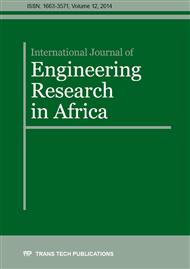p.1
p.15
p.25
p.35
p.43
p.53
p.67
p.83
p.95
Development of Model Equations for Selecting Optimum Storage Parameters for Stored Cabbages
Abstract:
A study was carried to develop model equations for selecting optimum storage parameters for stored cabbages in passive evaporative cooling structures.Three sets of four different types of passive evaporative cooling structures made of two different materials; clay and aluminium were designed and constructed as part of the study. One set consists of four separate cooling chambers. Two cooling chambers were made with aluminium container (cylindrical and square shapes) and the other two were made of clay container (cylindrical and square). These four containers were separately inserted inside a bigger clay pot inter-spaced with clay soil of 5 cm (to form tin-in-pot, pot-in-pot, tin-in-wall and wall-in wall) with the outside structure wrapped with jute sack. The other two sets followed the same pattern with interspacing of 7 cm and 10 cm, respectively. The set with 7 cm clearance served as the control in which the interspace soil and the jute sacks were constantly wetted at intervals of between 2 to 4 hours depending on the rate of evaporation with water at room temperature. The other two sets (5 cm and 10 cm interspaced soil) were constantly wetted with salt solution (sodium chloride) at the same interval to keep the soil in moist condition. Freshly harvested matured cabbages were used for the experiments and the temperature and relative humidity were monitored daily. The vitamin A, vitamin E, bacterial and fungal counts of this produce were determined at intervals of three days for a period of 21 days. Mathematical models (using essential regression software package) were developed to predict the vitamin A and vitamin E contents of the stored produce at various conditions considered in the study. Further analysis by optimization process revealed optimum storage conditions for the stored produce using essential regression software package. Optimum values of 8.86IU and 4.03 mg/ml in storage were obtained for vitamin A and vitamin E contents, respectively for stored cabbages at various conditions.
Info:
Periodical:
Pages:
95-105
Citation:
Online since:
June 2014
Authors:
Price:
Сopyright:
© 2014 Trans Tech Publications Ltd. All Rights Reserved
Share:
Citation:


